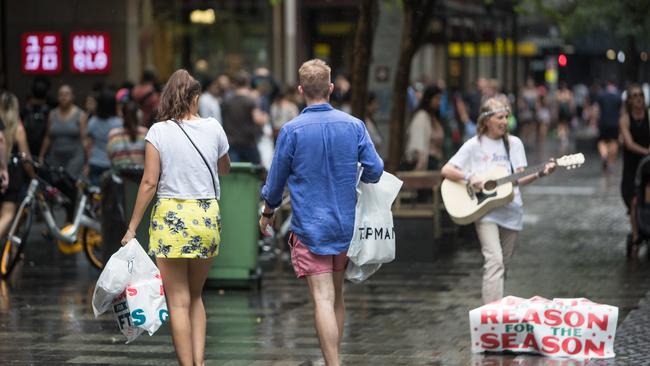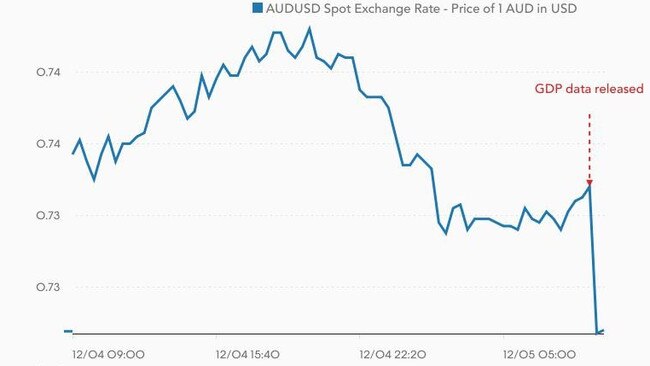Australian economic growth slows to weakest pace in two years
The dollar has dived after GDP numbers fell well short of expectations amid weakness in the retail sector.

Australia’s economy slowed to its weakest pace in two years, growing sharply slower than expectations, after a sharp falling in mining investment and amid weakness in the retail sector as stretched households reach their spending limit.
The official figures released on Wednesday, showing the economy grew 2.8 per cent over the year through September, well below expectations of a 3.3 per cent increase, could now force the government to downgrade growth forecasts into next year at its mid-year economic and fiscal outlook due later this month.
It’s an unwelcome slowing in economic activity for Scott Morrison, who has launched a federal election campaign on economic management as he prepares the first budget surplus in a decade ahead of a likely May vote.
The growth figures, released by the Australian Bureau of Statistics on Wednesday, were a significant slowing from the 3.4 per cent rate recorded over the year through June, amid broad weakness in construction, retail and the farm sector.
Household expenditure — the biggest driver of economic growth — was under increasing pressure as bills and necessities stripped ahead of record-low wage increases.
In a sign that slow wages growth is beginning to feed through to softer economic activity, spending on discretionary items slowed over the September quarter.
Australians are already putting away the smallest amount of their wages into savings in more than a decade, with household saving ratio falling to 2.4 per cent in the period. That’s the lowest saving rate since December 2007 and well below the 4 per cent rate recorded at this time last year — suggesting household finances are stretched amid slow wages increases.
The spending figures will worry economists, who have warned that consumption is likely to slow amid escalating price falls in the property market as consumers are scared into closing their wallets, particularly ahead of the important Christmas trading period and into next year’s federal election campaign.
The Australian dollar fell half a cent on the release of the figures.
Josh Frydenberg said the figures would not change the government’s plan to hand down a federal budget surplus next April.
“The Australian economy doesn’t run on autopilot,” the Treasurer said. “Difficult decisions have been taken over the past five years. Record jobs growth and the strong numbers we’re seeing across the economy are an indicator that our economic plan is working,” he said.
Mr Frydenberg said the falling household savings rate was a sign consumers were confident of the economic outlook.
The September quarter’s growth rate of 0.3 per cent was the slowest since the same period in 2016, and was half the rate expected by economists.

However, the ABS figures showed households were not spending on discretionary items, with retail figures, car sales and furnishing soft.
Household expenditure — the biggest driver of economic growth — slowed to 2.8 per cent over the year. Meanwhile, the figures showed shops were finding it harder to shift stock. Over the September quarter, inventories in the retail sector showed the largest build up since December 2015.
“The economy lost momentum moving in to the second half of 2018 centred on housing and the consumer against the backdrop of a further tightening of lending standards to the housing sector,” said Westpac economist Andrew Hanlan.
A drop in mining investment, as the resources investment boom dwindles, was also a major drag on the economy, falling 13.6 per cent over the year. Investment in the non-mining sector was largely flat.
CommSec chief economist Craig James said the economy was performing well.
“Economic growth is above ‘normal’, inflation is contained, the jobless rate is at six-year lows and interest rates remain at record lows,” Mr James said. “Economic growth was a touch softer than expected in the September quarter, but this only highlights that the economy does bob around from quarter to quarter,” he said.
“The main negative was inventories. But if business ran down the stocks sitting on shelves then this may serve to boost production in coming quarters in order to meet demand.”
Capital Economics senior economist, Marcel Thieliant, said economic growth will slow further to next year, undershooting RBA forecasts.
“Even if GDP growth rebounds to 0.6 per cent in the fourth quarter, it would only increase by 2.9 per cent this year,” Mr Thieliant said.
“That’s much weaker than the RBA’s forecast of a 3.5 per cent increase, and we believe that the full effects of falling house prices and tighter credit conditions have yet to be felt,” he said.




To join the conversation, please log in. Don't have an account? Register
Join the conversation, you are commenting as Logout